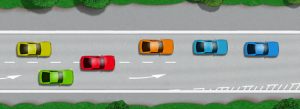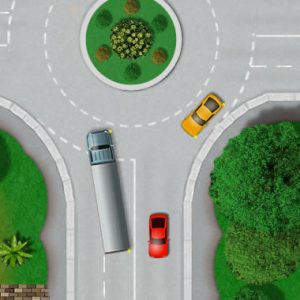Lane straddling is where a vehicle is positioned over lane lines rather than between them, therefore it’s occupying more than one lane. In many circumstances, this is simply down to inconsiderate and careless driving, though in certain circumstances it’s necessary. Let’s look at some examples of lane straddling, both inappropriately and when it’s necessary.
Examples of Lane Straddling
Intentional lane straddling can be seen in a slow moving queue of traffic, where queue jumpers race along the overtaking lane (or any other lane that get’s them ahead), only to abruptly push their way into a gap at the merge point.
If both lanes merge together, if the road conditions are right and if done properly, using both lanes actually helps to reduce congestion – this is called zip merging. Instead, most drivers tend to queue and some find it irritating when passed by another driver who hasn’t spent time queuing.
The irritated driver may straddle lanes, preventing the queue jumper from getting ahead. This is best avoided as it may increase congestion and cause tempers to flare.

Accidental lane straddling, or bad lane discipline often occurs at roundabouts where a driver isn’t paying attention to lane markings, resulting in them straddling lanes.
This can easily result in a collision and is particularly unpleasant if you happen to be a motorcycle or bicycle rider that they collide with.
Necessary Lane Straddling
Generally, cars never need to straddle lanes, long vehicles on the other hand often do. Many town and city centres were built during a period where huge lorries (HGV) weren’t invented, so it stands to reason that roads within these areas aren’t best suited to them.

Being very long, these vehicles will often need to take an alternative path at roundabouts and junctions, else they may collide with roadside objects or mount the pavement. Bus drivers and even drivers of large vans also find certain roads challenging.
Always consider the extra room that a long vehicle may require when they are turning. If in doubt, stay back and allow the vehicle to finish manoeuvring. The last thing you want is to be in the lorry drivers blind spot when it is making a turn.

When you mention necessary Lane straddling, who would be liable if the bus maneuver into your car without looking? assume the car at the blind spot, it is the first rule of driving is look before maneuver, isn’t it? Specially driver have to check your blind spot before straddling lane. It is advise to leave them big vehicle plenty of room, but car don’t have to give way right? should the big vehicle slow down look first before straddling? What is ground to argument when bus driver tell you its their right to straddle lane on the round about? what if bus (on the left lanes) speed up (or travel at higher speed) to past car on it’s right side then straddle without looking cause the collision. What should be the liable evidents?
Hello Hoe Duong,
I would think that if the bus driver manoeuvred into your car due to straddling a lane without even attempting to look whether it’s safe to do so, would without doubt put the bus driver at fault. Large vehicles do of course require more space and do on occasions need to straddle lanes, but the drivers should make every effort to ensure it’s safe before proceeding. It is of course always advisable to give large vehicles space at junctions and roundabouts and to avoid where possible to drive in their blind spots – but this isn’t always practically possible. Ultimately, it has to be the driver of any vehicle to ensure they do not cause a collision.
A lane splits into two and after a while merges into one again. When it splits, there are parked cars found covering some part of the left lane. Is it okay for a vehicle passing to straddle lanes then? Occupying some part of the left lane after leaving enough clearance for parked vehicles and occupying some from right?
Hi Jyoti,
If the section of lane where the parked cars are is relatively short, straddling the lane is fine, provided as you say, you’re leaving plenty of clearance from the parked cars. If it’s a longer stretch of road, then I would be more inclined to position myself in the right lane. By using the right lane, you’ll be making your road position clear to other road users.